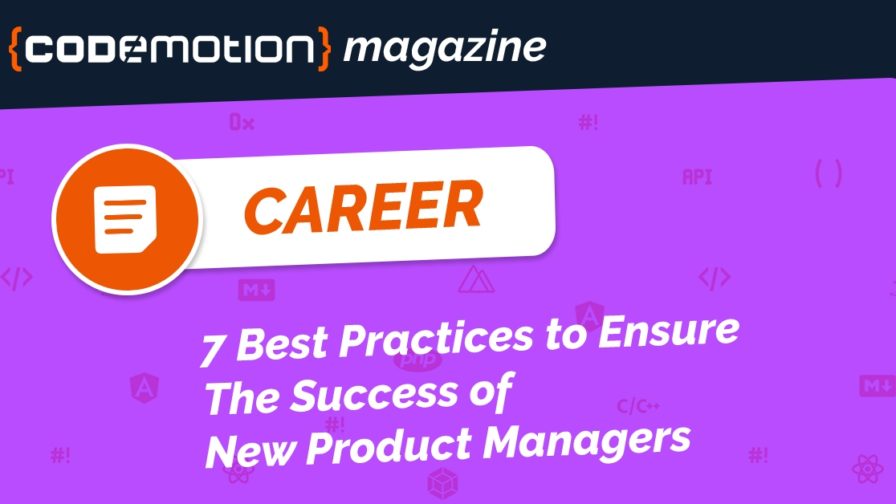
On paper, a product manager’s job is straightforward: to drive the success of software development projects. However, in practice, it’s more difficult, because you are dealing with a team, customers, and executives who have different needs and pain points.
It’s your job to manage interpersonal relations while overseeing critical activities that determine the project’s success.
The success of a product relies on having an effective product manager. Excellent product managers encourage innovation, foster a positive and healthy work environment, and make informed decisions on the product vision.
If you are thinking of moving from Dev to PM, below we discuss best practices to ensure you become a product manager with these qualities and a portfolio of successful products.
1. Develop Meaningful Relationships
The first thing you need to do as a product manager is to develop meaningful relationships with your team. You rely on them to develop successful products and your team needs to know they can rely on you too. Consider the different ways you can build relationships at your company.
Get to know your team and understand their pain points
Building relationships within your product development team is essential. This should happen both during and outside of work hours. Retreats and team-building exercises should focus on developing the following teamwork examples:
- Roles that are understood and owned.
- A willingness to share. This includes insights, resources, or feedback.
- A culture of respect and kindness.
- Proactive communication.
- Setting goals and growing together.
The way to ensure your team achieves these goals is to know each member. What does each need to do their job? Where can their strengths re. their hard and soft skills be applied most effectively?
To know the answers to these questions, keep an open dialogue and actively practice and promote team building within your company.
Spend time with your support staff
While it’s important to get to know teammates, don’t forget the other people who make your accomplishments possible. Spend time with your support staff and consider their role in the product development process.
Make sure their work doesn’t go unnoticed and they’re properly recognized, along with your team, for the success of a product.
It’s important to have cross-functional leadership across departments. The only way to do this effectively is to get to know the needs of individuals in each position you’re in contact with. Spend time with the staff and get to know what they require to do their job effectively.
Also, listen to what skills and knowledge they can provide to drive your projects toward success. If your support staff work remotely, use web conferencing to stay connected. You can create a space for interdepartmental communication and cooperation by utilizing virtual social hours or interdepartmental chats.
2. Learn the process
When you first enter a company, learn how they work through product development. Consider the strategies and process as a whole and know that it takes time to understand an organization and product.
Spend this getting to know the business, market, customers, and team before you start making suggestions. Learning the process includes:
Understanding the business
Make sure you familiarize yourself with the company’s business objectives and brand strategy. Review quarterly reports and all-company meeting notes. Meet the company’s other leaders to understand their department’s processes and goals. This will foster collaboration between developers and other departments.
Some questions to ask are:
- What are the company’s mission, strategy, and vision?
- What is currently influencing the company’s approach to product development?
- What sets this company apart from its competition?
- How is success measured at this company?
Focusing on the bigger picture
When you are learning the process of product development, focus on the bigger picture. Understand how your position fits into the wider mechanisms of company operation. Know how your team can contribute to other departments’ goals and how they can contribute to yours.
Don’t just look for success within your team but consider the ways you can be supporting the company as a whole.
Ask a lot of questions
As a manager, you should always ask questions, but this is most important during your initial weeks with a company.
Ask different departments and members of your team anything and everything about the company and their role in it. Be curious and open to new ideas while considering how to best move forward with your position.
Also, ask questions about product development and branding. What will your role be in matters like product lifecycle management? How will you integrate the company’s brand voice into your product’s development?
3. Know the market and your competitors
After or while you’re getting to know the organization, look at the wider market and the competition. The best product managers research their rivals and know the ways to evaluate the state of the market and their competitors.
To get a feel for what is out there, ask yourself:
- Are there other organizations working on similar products?
- Are potential clients getting a product that matches their expectations in terms of quality and use?
You should also:
- Define the market landscape: A well-rounded market analysis evaluates customer needs, industry changes, and fiscal opportunities.
- Identify your competitor’s vision: What problems do they wish to solve and why do they exist?
- Differentiate the competition: Investigate the ways the competitor’s product differs from yours. For example, if you are developing inventory management software, what feature or function does it have that isn’t seen in other similar products?
- Evaluate your competitors’ position within the market: How does your competition fit themselves within a shared market?
- Know your competitor’s strengths and weaknesses: This will allow you to consider where you fit within the market and how you can fill specific needs. You need to know your competition’s struggles and strengths to strategize your product’s release.
In the end, you don’t want to release a product that already exists. It can be similar to an existing product, but it must have a distinctive feature or characteristic that sets it apart.
This step of research and development is vital for any new project. A new evaluation of the market and competition should take place with each new product development.
4. Create, review, and revise your roadmap
During product development, a roadmap provides a broad overview of all aspects of the project. It will outline specific goals, timeline, features, and resources. A product roadmap will allow you to create forward-looking objectives and a rough timeline.
This tool also improves communication by providing a hub where stakeholders can weigh in on goals and progress.
Use the following steps to create an effective product roadmap.
- Define a product strategy: What is the vision for your product? What problem will it solve?
- Gather requirements: Talk to your sales and support team, engage with users, and tap into your team’s product knowledge to pinpoint specific requirements for your product.
- Make a timeline: This should be a rough outline of certain target benchmarks. It needs to set specific goals while leaving room for innovation and adaptability. This timeline can be generated manually, or you can use product management software. Consider looking into alternatives to Trello, for example.
- Tailor your roadmap to the stakeholders: Your product’s success relies on other internal teams. Gain their support by speaking to their interests. Find areas in every product that speak to your stakeholders.
- Share your roadmap: This will encourage team engagement and interdepartmental support.
After you share your roadmap, continuously review and consider revisions. Because you left room for innovation in your plan, the product strategy may change, you may have different requirements, or your timeline may shift. By having an adaptable roadmap, you keep communication high while providing a fluid workflow.
5. Don’t make risky assumptions
When you are developing a new product or taking on a project already in development, don’t make assumptions. Ensure you’re making data-driven decisions, not ones based on instinct. Use multiple channels to collect data that you will use directly in product development and rollout.
Listen to customers
This needs to happen before and after product development and before its full release. Get feedback loops and sampling analysis.
Products can be tested in-house but offering beta testing to customers can introduce users to your product and produce the widest variety of testing conditions and the largest number of testers. This allows you to develop a more inclusive design.
Also, use data collected by other departments, like sales or marketing, to complete data and behavioral analysis. Understand your customers’ habits and needs before development. What have your company’s users responded well to in the past?
Use KPIs
The best way to implement data-driven decision-making is by using key performance indicators (KPIs). KPIs are values that can be calculated to measure how well an organization is performing against key objectives.
Choose KPIs that are:
- Available and measurable
- Highly impactful
- Relevant
- Instantly useful
- Timely
Key performance indicators may differ from product to product. Use interdepartmental collaboration to determine what KPIs you should track and what goals should be set for each one.
This will keep your decisions based on data while still promoting a collaborative culture. Use online productivity tools to help organize objectives and changes generated by KPIs.
6. Maintain a healthy work environment
The development and rollout of a new product can place a lot of pressure on a team. It can be difficult to keep them working together effectively while managing the diverse stakeholders’ expectations and wishes.
Here are some things you can do to ensure that you maintain a healthy work environment during periods of heightened stress.
Make sure roles are clearly defined
Everyone on your team should know and own their role within each project. This becomes even more important if your team works remotely.
Managing virtual teams can be an added challenge, so make sure your team knows who is working on what and how their tasks fit in with the bigger picture.
Advocate for your team
As a manager, you need to look out for your team’s health and wellbeing. Make sure you set reasonable goals and deadlines. It may be the case that an external stakeholder is asking for a certain deadline. If it is too much pressure on your team, you need to be able to take the heat when putting forward an alternative rollout date.
7. Provide vision and clarity
For a product to be successful, it needs both vision and clarity in each step of the process. The product manager needs to have an overarching comprehension of the product to be able to guide it through the process. Consider how you can keep a clear and effective vision in product development.
- Use a common language: Make sure you use language in internal documents that can be understood by every member of your team and across departments. When presenting, consider using screen sharing to illustrate more complex ideas. Look into the best free screen share solution for your company.
- Recognize the bigger picture: Understanding the objectives of the product is essential for success. Always have the bigger picture in mind.
- Make no concessions: Or rather, be careful about what concessions you make. With various stakeholders and potential users, it can be tempting to try to cater to all stakeholder’s wants. Test ideas, but do not commit to anything that doesn’t contribute to the bigger picture.
Conclusion
Stepping into a product manager position can be daunting. Product management and building a functional team require planning, observation, and an eye for data analysis.
However, by using these best practices you will be able to effectively manage your team while developing innovative and user-driven products.
Every company should actively look for managers who illustrate the soft skills mentioned in this article. Consider which skills you have, like team building, collaboration, and curiosity, and which you need to develop further.
Through consistent self-evaluation and an eye towards best practice, you can be a successful product manager.


